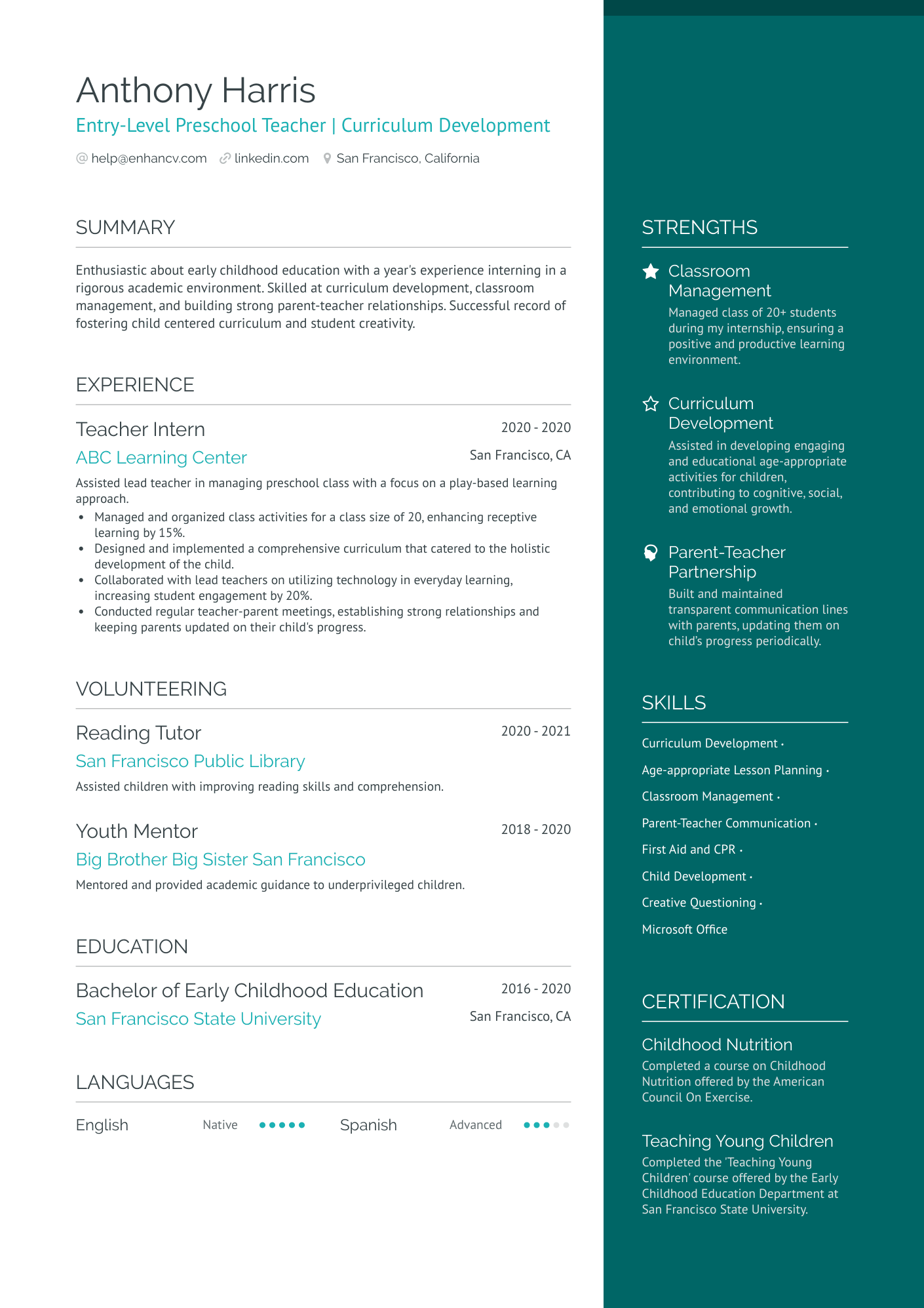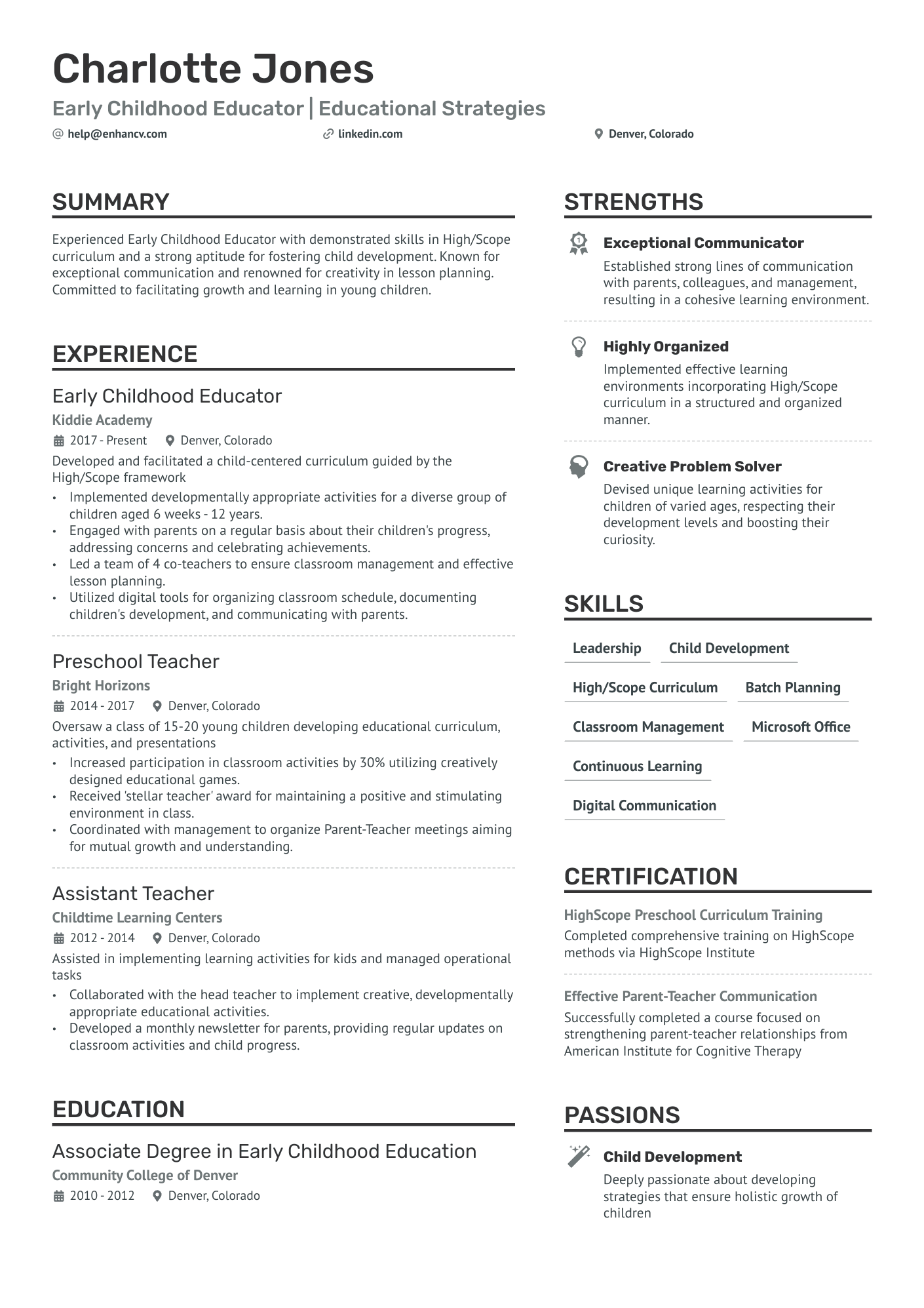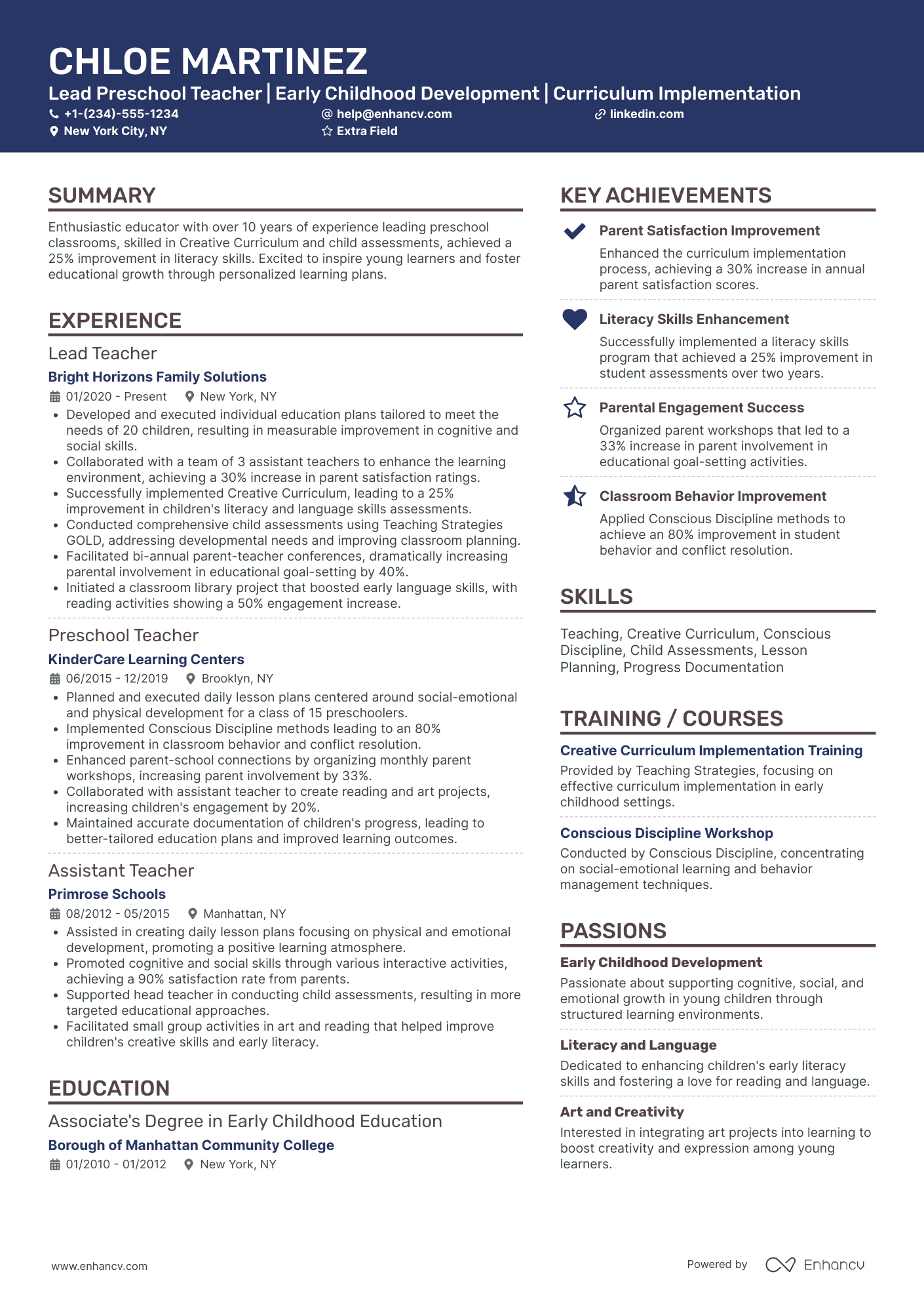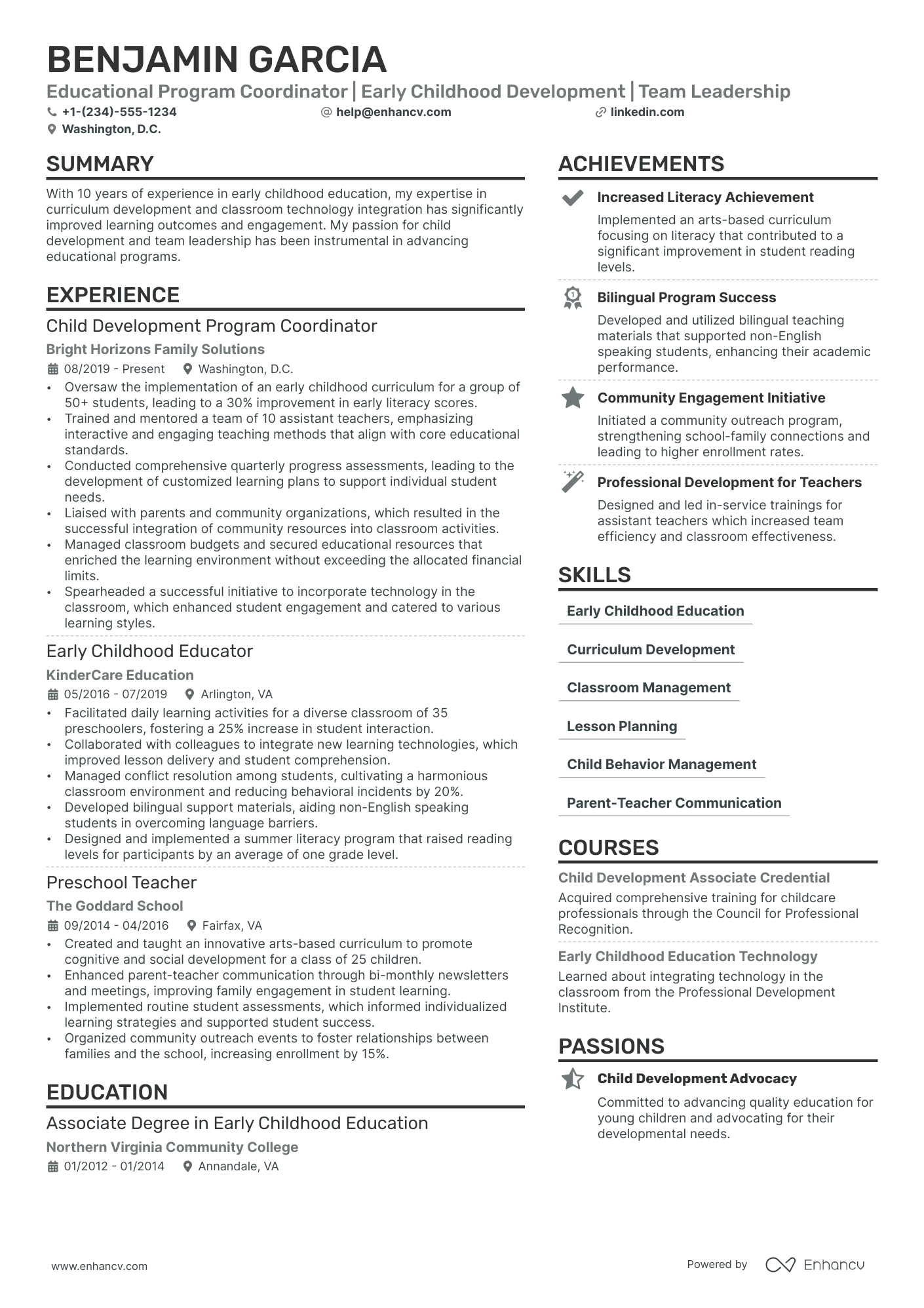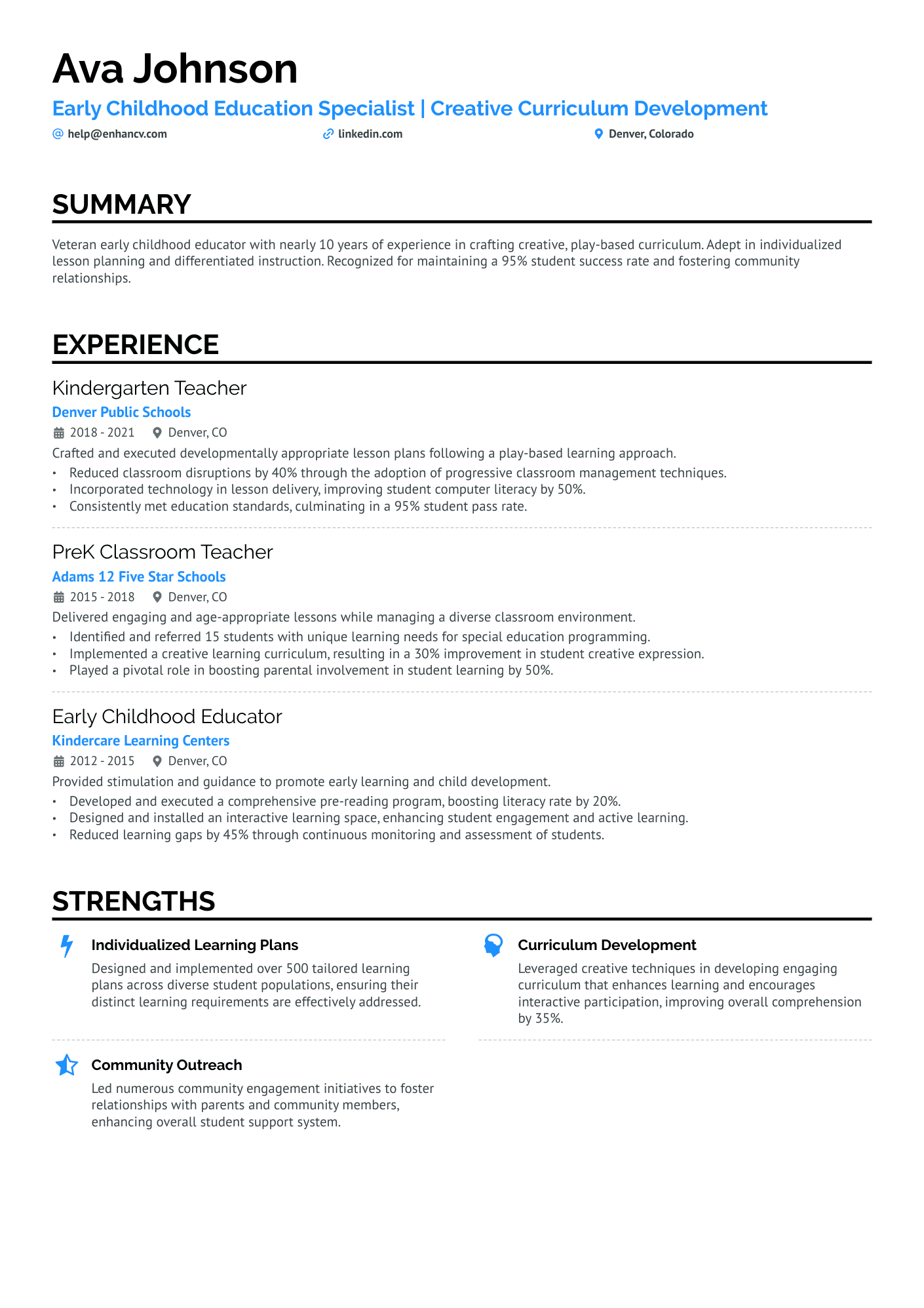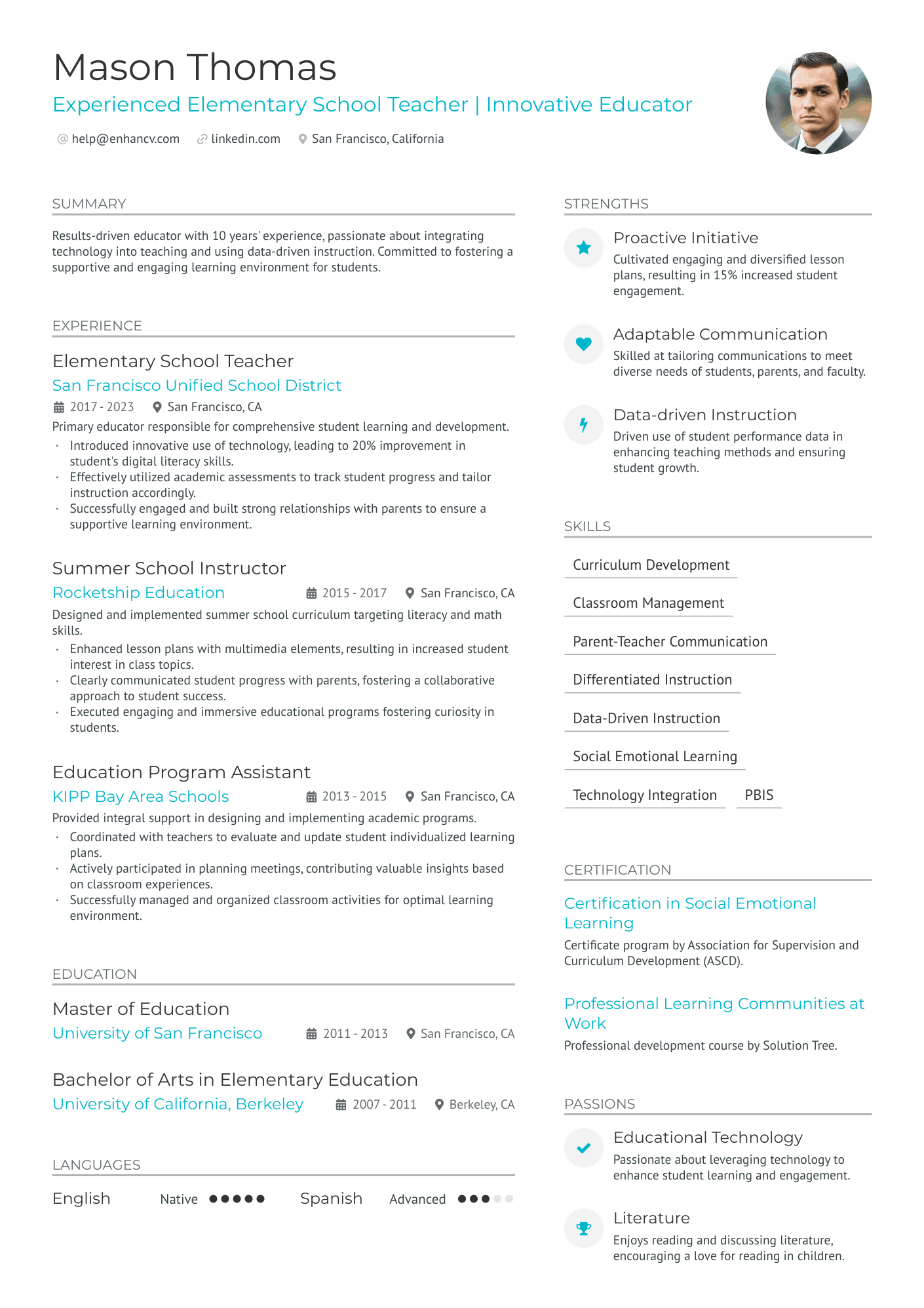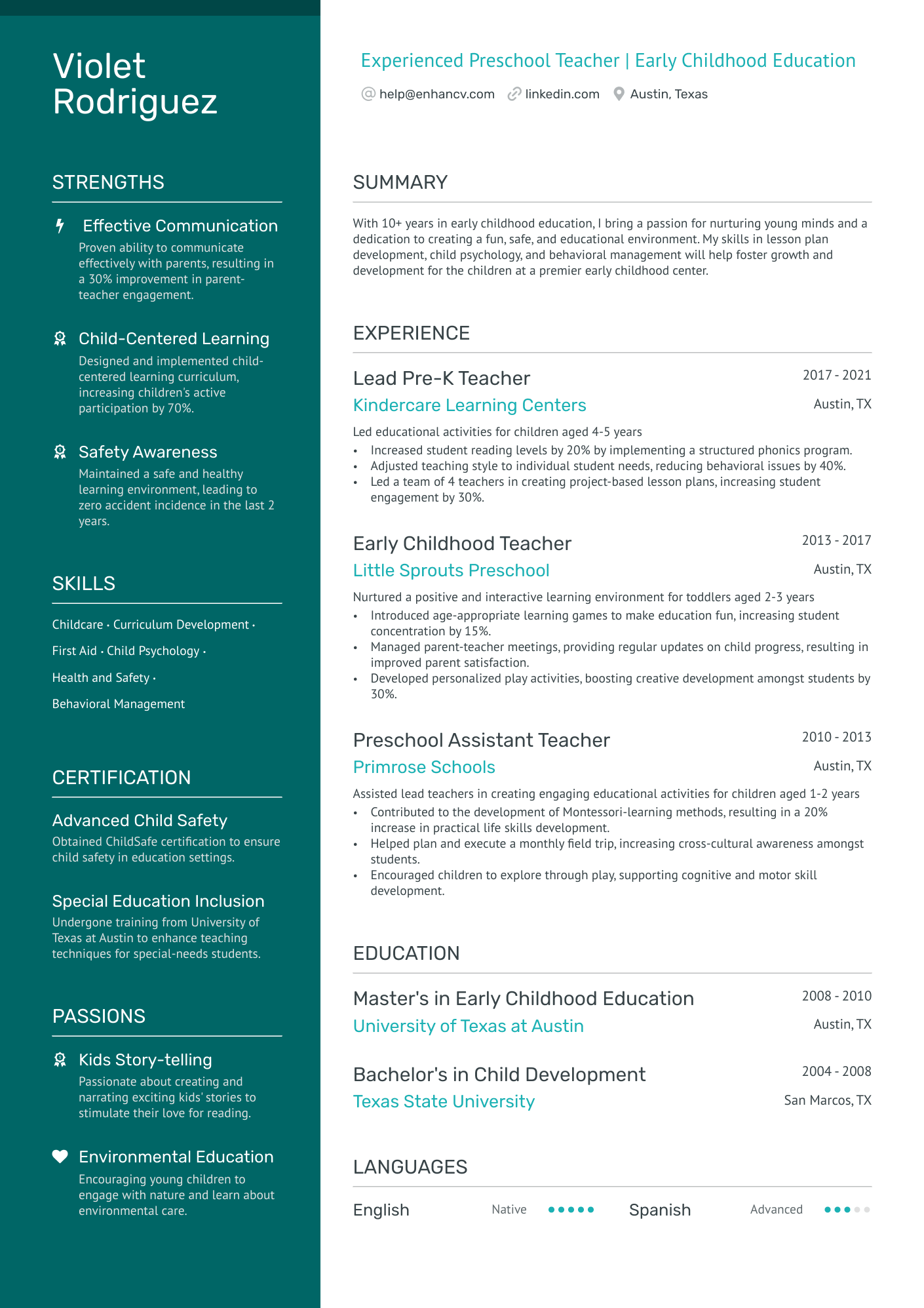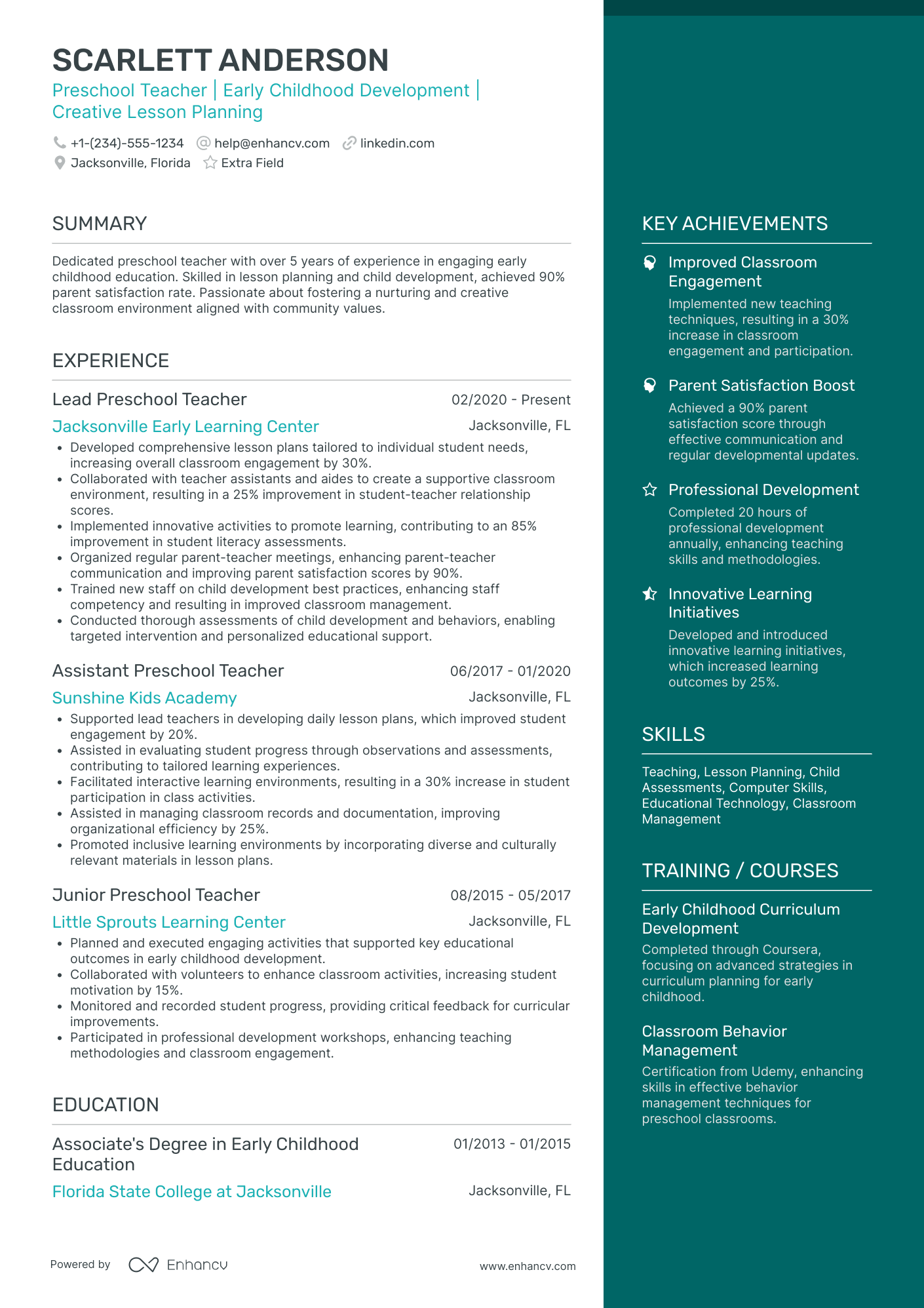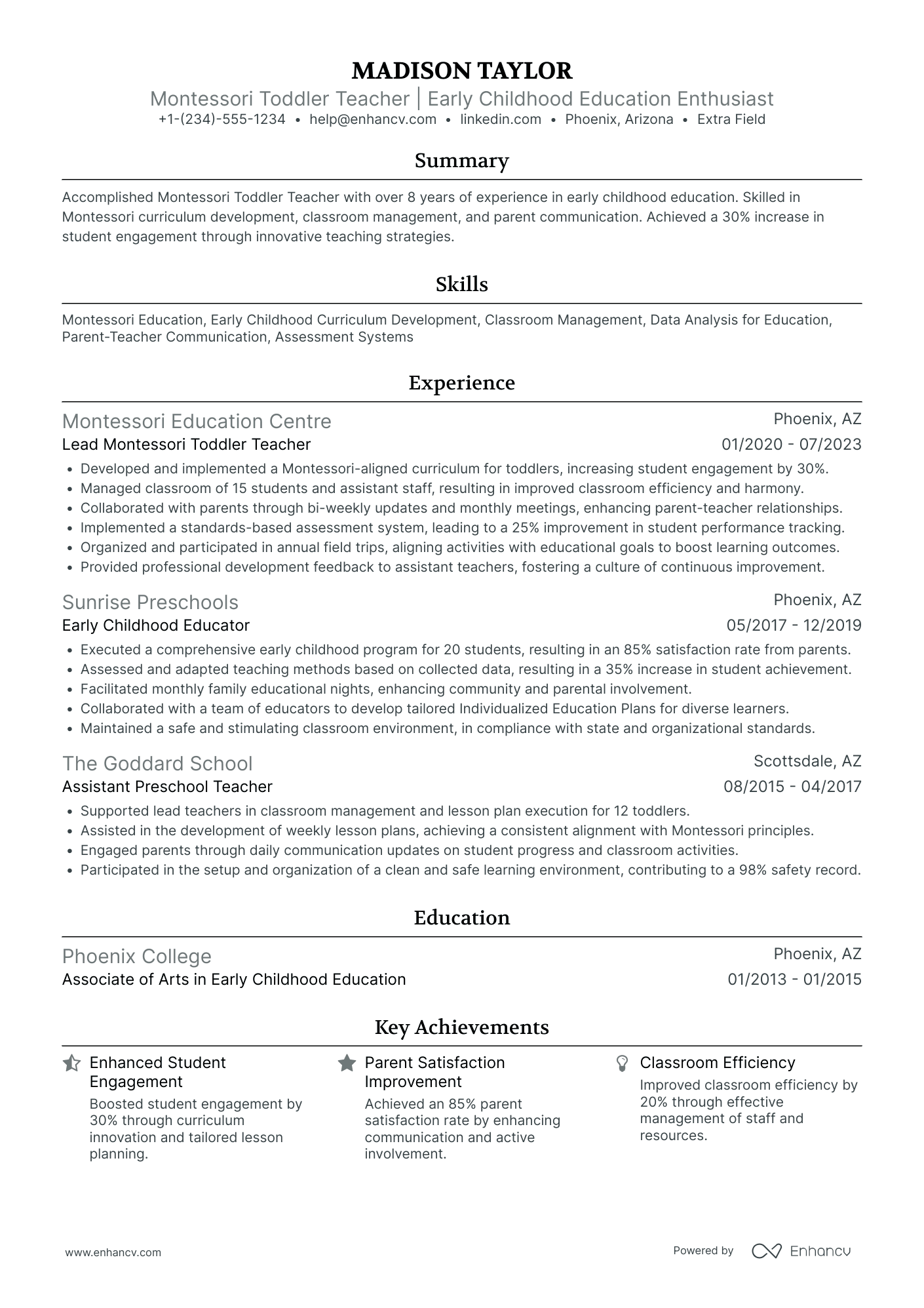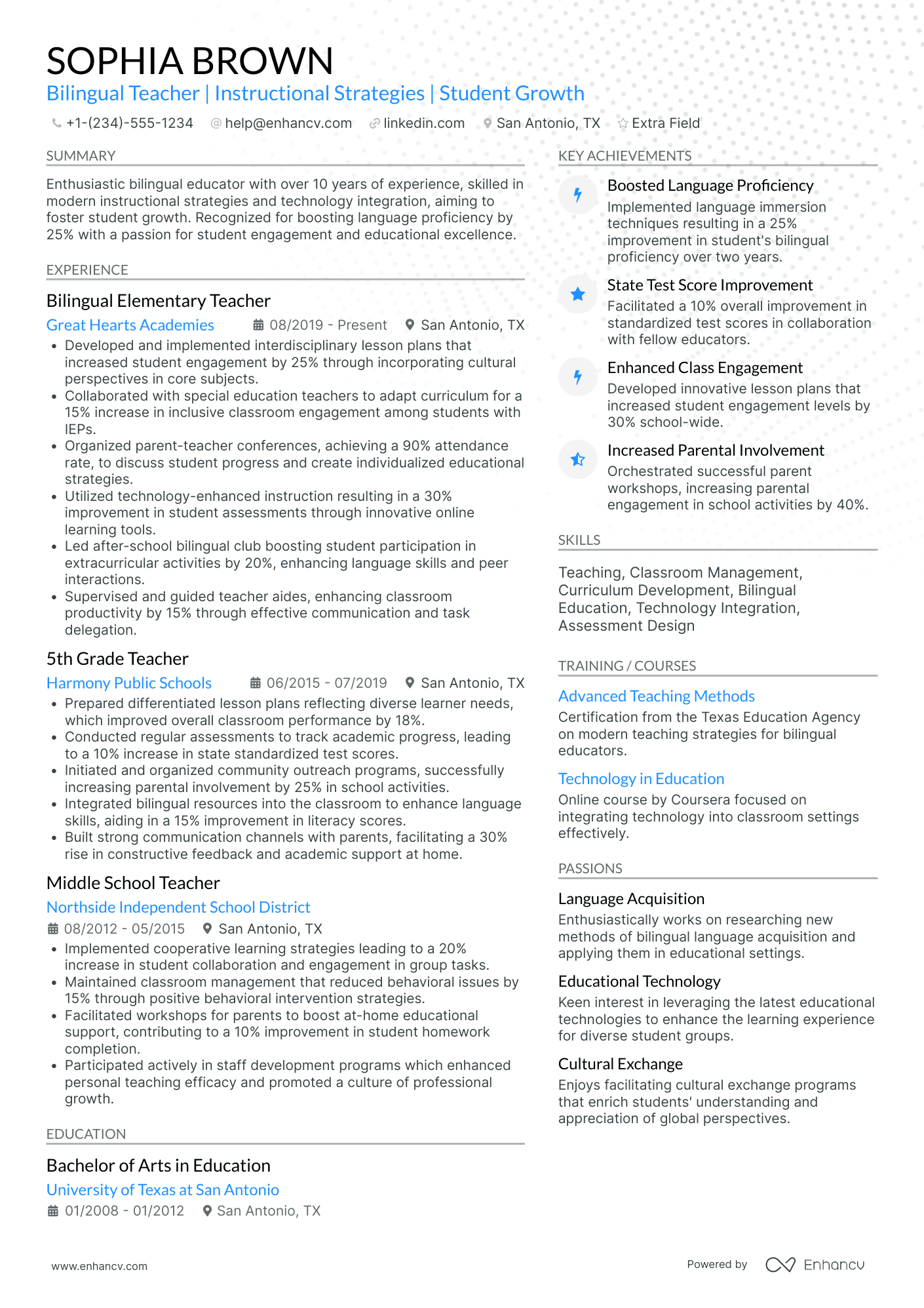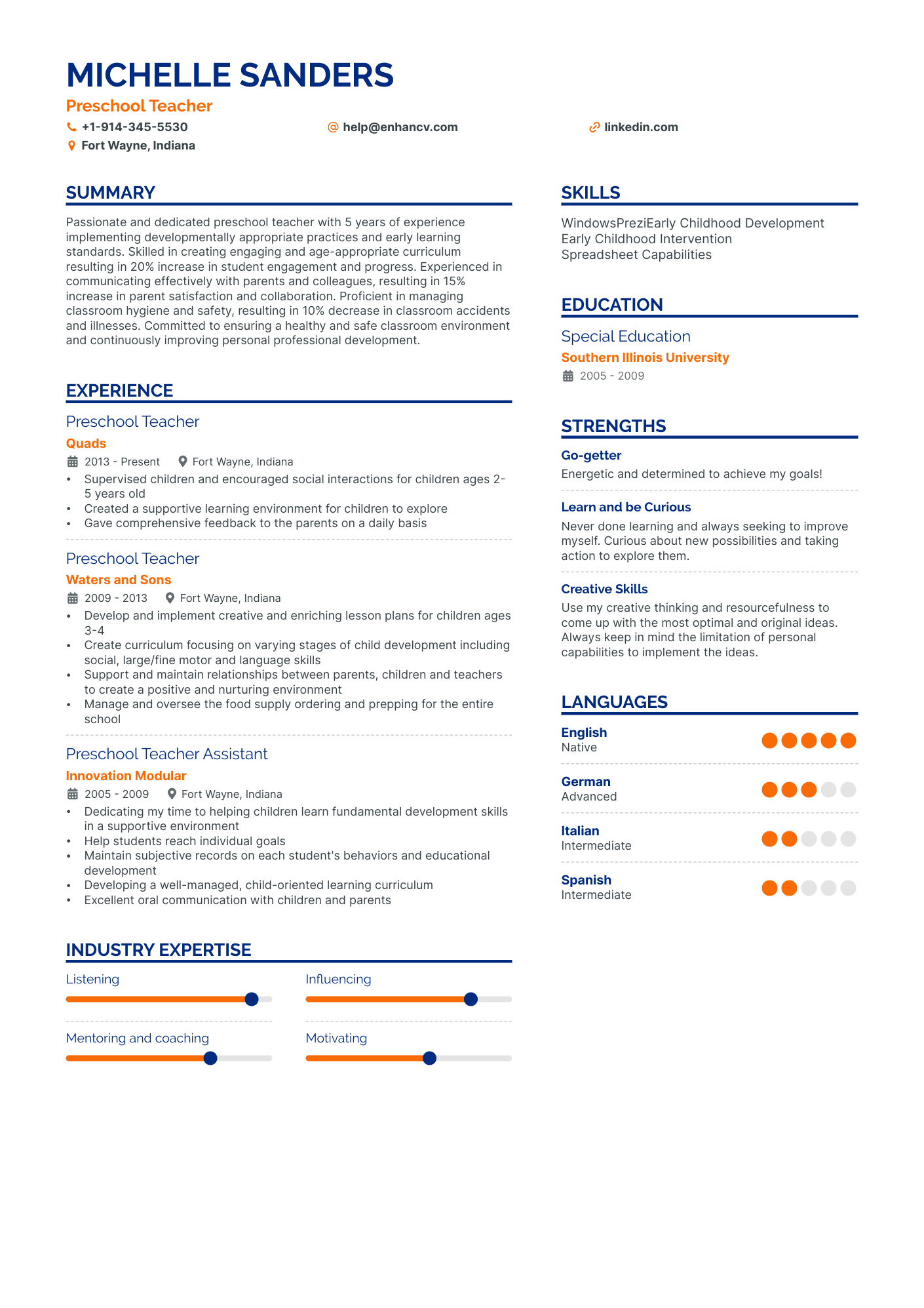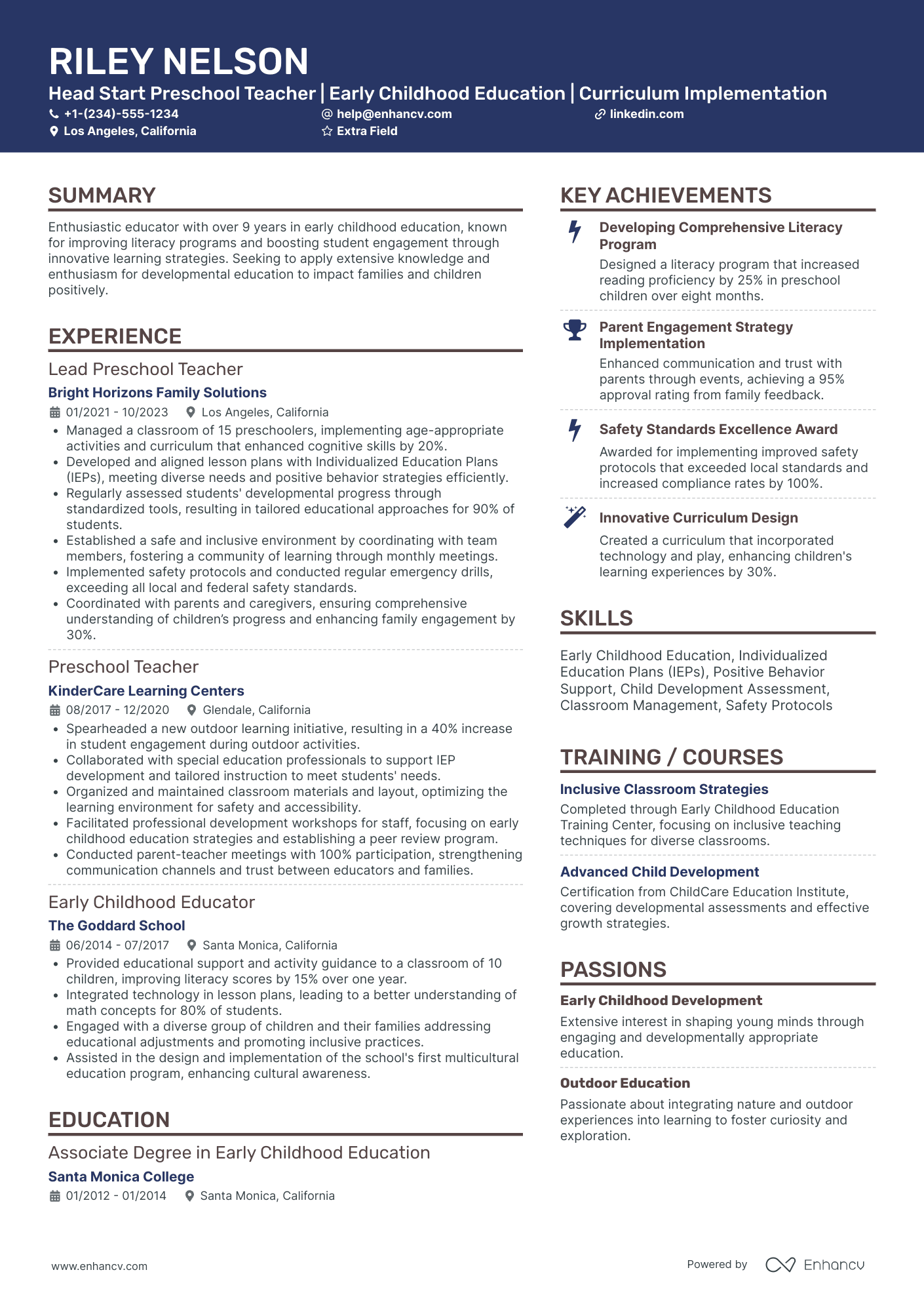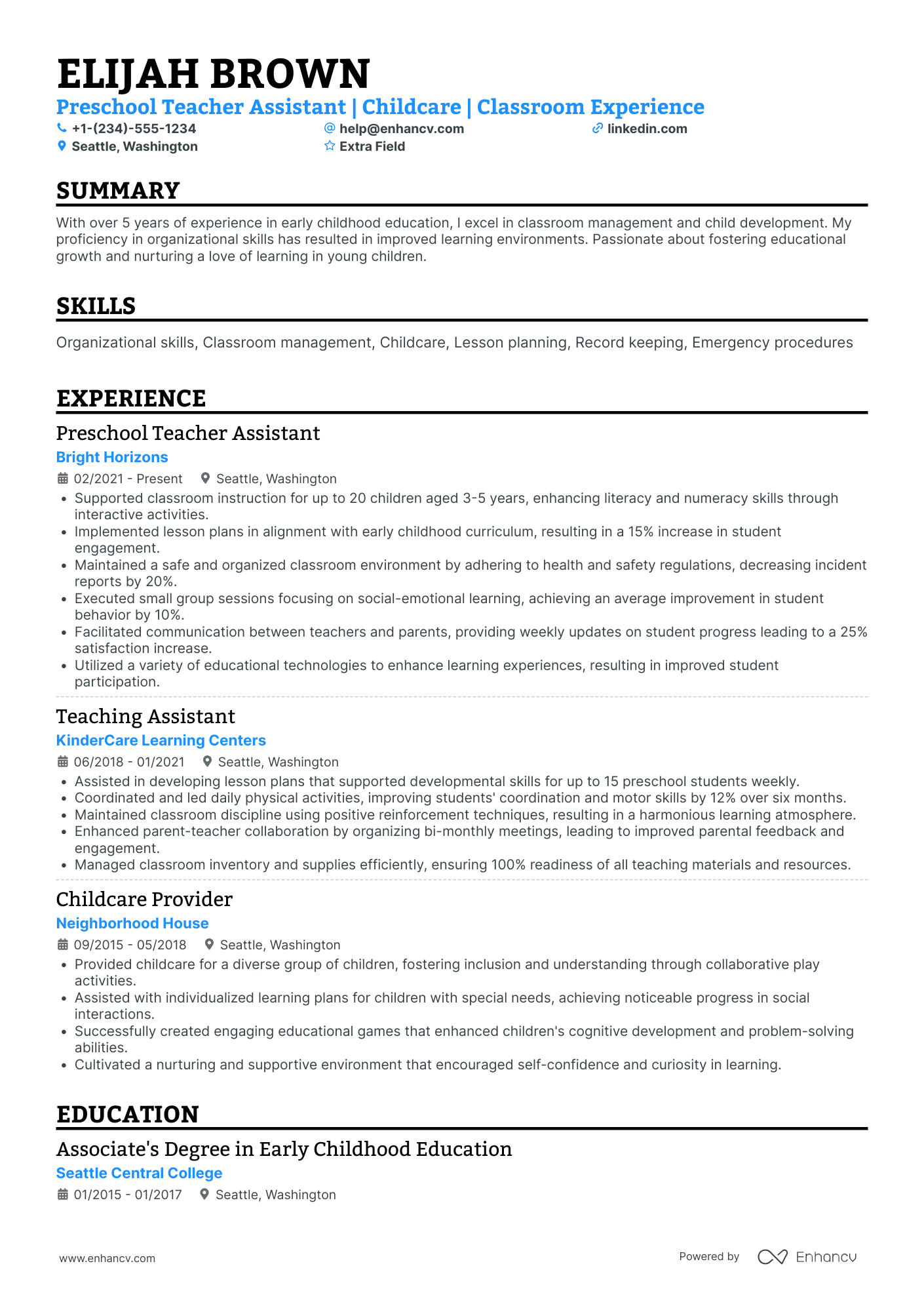Preschool teachers don’t get the credit they truly deserve. From juggling the responsibility of calming a screaming toddler by rubbing their back to cleaning up the reading nook with your other hand simultaneously, you truly are a superhero without a cape. With such a diverse skill set, it’s a challenge to make school admins recognize your full worth on a resume.
In this guide, we will cover:
- How to make a resume for a preschool teacher which will stand out from the pack
- Some great professional resume examples to help you craft your own
- Tips on how to include unique skills and certifications in a clutter-free fashion
- how to emphasize crucial aspects of a preschool teacher’s role, like: lesson planning, creating a nurturing environment, implementing age-appropriate activities.
- How to craft an eye-catching preschool teacher resume summary to grab recruiter’s attention from the start
Looking for a position close to a preschool teacher? We've got a lot more resume guides for you:
- Teacher Resume Examples
- Summer School Teacher Resume
- Montessori Teacher Resume
- First Grade Teacher Resume
- Child Care Teacher Resume
- Kindergarten Teacher Resume
- Infant Teacher Resume
Preschool teacher resume example
Three reasons why this resume works:
- What makes this resume so good is that it hammers home quantifiable, tangible data on why this person should be hired. They didn’t just engage students, but created a “20% increase in student engagement and progress.”
- Also, the unique skills listed help to differentiate the applicant’s resume from other resumes.
- Although a strength section isn’t necessarily needed, in this case it helps to show unique abilities which can make the applicant thrive in a classroom setting. This includes mentioning that you’re an energetic preschool teacher.
How to format a preschool teacher's resume
The first impression you make with a hiring manager is usually done through your resume, and that’s why it’s important to make sure that its formatting is flawless. If you don’t use headings or bullet points properly, you come off as sloppy, ill-prepared, and without a clear message. In addition, the design of your resume can actually help you to catch the attention of a potential manager.
Below, you can find some of the most common formatting concepts to consider for your resume:
- Reverse Chronological Format: a reverse chronological format is when you list the most recent experience first on your resume. The reason why this format is the most widely used one is that you can highlight your career trajectory, including where you started out at the bottom and the success you’ve achieved in your most current role.
- Header: Your header is the first thing that jumps off the page of your resume. In your header, you can include contact information on how to reach you, as well as a photo of yourself.
- Length of resume: Although there’s no cut-and-dry rule for how long a resume should be, it’s best to stick to between 1-2 pages, with one page being the most common length.
- What file format to use: Unless otherwise specified, the PDF file format beats out a simple Word document because PDFs are easy to share and don’t have the same issues with images shifting around.
Adjust your resume layout based on the market – Canadian resumes, for example, may follow a unique format.
The top sections on a preschool teacher resume:
- Resume Summary: A resume summary is a short elevator pitch where you can share what makes you the best person for the position.
- Experience: Your experience section is one of the most important sections on your resume, as you can directly link your most recent experience to the skills and abilities you cultivated over your career.
- Education: Where you went to university can be important in the hiring process. If you went to a prestigious school, this might allow you to bargain for more money or apply for a more senior position.
- Skills section: Think of your skills section as your Swiss Army knife of abilities: you list all the things that make you exceptional, and stand out against other applicants. Always make sure to quantify your skills, using real-world examples like figures from test results and percentage points from parental surveys.
- Certifications, licences, and awards: In the teaching world, having a unique certification can give you the upper hand in receiving the position that you’d like to be hired for. For example, if you have a certification working with children who have special needs, this can give you an edge in the hiring process.
What recruiters want to see on your resume:
- Experience with adapting your teaching models to the needs of each student, including your experience crafting Individual Education Plans (IEPs).
- Effective classroom management strategies to create engaging and developmentally appropriate lesson plans for early learners.
- Excellent communication skills with parents, maintaining an open line of communication with the caregivers to promote a partnership in learning.
- Demonstrated knowledge of health and safety protocols, ensuring a secure and conducive learning atmosphere.
- Showcasing your desire to stay up to date with the latest teaching trends through professional development courses and certifications.
How to write your preschool teacher resume experience section
As mentioned above, your resume experience section is the crown jewel of your resume. In fact, it is the first thing that hiring managers seriously consider when they’re looking for a candidate to fill a position. After all, a manager wants to know where you’ve worked before so they can decide if you’re a good fit for them.
Your experience tells the story of your career: where you’ve been, what you’ve achieved, and how a future position might fit into your overall goals.
Below, you’ll find an example of two resume experience sections. One is the wrong way of creating a resume experience section, while the other highlights a great resume experience example.
- •Created an age appropriate learning environment
- •Helped create a curriculum and developed weekly lesson plans
- •Cultivated rapport with parents
- •Developed classroom management techniques which helped to cultivate an age appropriate learning environment.
- •Created and refined a curriculum which promoted reading through creative lessons and increased the literacy rate on average by 30%.
- •Promoted a professional learning environment which had an average parent satisfaction score of over 95%.
- •Taught classes which promoted a classroom environment best suited for learning by using the Direct Instruction model of teaching.
What works in this resume experience example
The second resume experience section excels because it nails down concrete examples with quantifiable successes. The first experience section above simply lists achievements in a rather boring manner.
The second showcases the improvements that they made using facts and figures. Not only did the applicant promote a professional learning environment, but they also had parent satisfaction scores of over 95%.
Also the first example lacks a clear, fleshed out understanding on how the applicant achieved success through their previous experience.They simply ‘helped create a curriculum,” but that doesn’t really explain how they crafted a curriculum best suited to learning.
But in the second example, they’re able to quantify their contribution to literacy, and this helps to show that they’re competent in their role. In addition, the applicant mentions the specific model of teaching (Direct Instruction) that they use, which a hiring manager may already know about.
How to quantify impact on your resume
Numbers are important for us as we make choices in our day-to-day life. If you knew that you only had a 50% chance of successfully completing a task, you’d find other ways to help bolster that number to a higher percentage.
The same goes with writing your resume, as the numbers that you list can actually help to show that you know what you’re doing and that you’ve found success in a previous role. Not only that, you can show how much success you’ve had by sharing the numbers. In your role as an educator, you have a difficult task of trying to put numbers on the progress of a young person’s learning. But you do this every time you write a report card, giving different grades to each student according to their skills and abilities.
What grade would you give yourself in previous experience? What are some specific initiatives you’ve implemented to promote learning?
Here are some quantifiable achievements which you can include in your resume experience section:
- Improvement in student performance
- Parent satisfaction
- Classroom management
- Curriculum development
- Training and professional development
- Awards or specific recognition
- Number of students taught
- Progress your students have made in key development areas
How do I write a preschool teacher’s resume with no experience?
It may be difficult to break into the teaching field if you have little to no experience. However, you have more experience than you think. Whether in high school, university, or out in the job world, you could show that you are a credible and competent teacher by what you’ve achieved.
Below, you’ll find a step-by-step instruction guide to help you if you have no experience:
- Write a resume objective: Writing a resume objective or summary can be different depending on your level of experience. For those who have decades of experience under their belt, they may have more of an opportunity to share real-world examples on how they’ve succeeded in the roles. But if that’s not you, don’t fret, as you can also share your goals and aspirations for the position you’re applying for. Be sure to share your passion for early childhood development.
- Use applicable experience to show competency: Although you may have never worked in a school environment, there’s a good chance that you have other professional experience which can make you an ideal choice for a position. For example, if you have worked or volunteered at a childcare center, this might be something where you can showcase your abilities.
- Highlight your education section: If you’re fresh out of school, you can show that you're a good fit for the role that you’re applying for by mentioning projects that you worked on in your degree. Maybe one of your classroom projects at university was to write a full curriculum for a fourth-grade classroom. Include that on your resume, and share briefly your research on the topics.
- Consider the hybrid resume format: The hybrid resume format is one that’s great for people who are new to a position because with that, you are able to highlight your skills on the same level as your experience. So, for example, you may wish to include two columns, one on the left which has your experience and one on the right which has your skills. Under the skills section, be sure to list all skills and practical examples from your life and career.
How to list your hard skills and soft skills on your resume
As a teacher, you have a lot of soft skills, interpersonal or ‘people’ skills, which allow you to thrive in any workplace. But you also possess hard skills, technical skills specific to your workplace. From mastering online presentation software to curriculum development, you have a lot of skills which you can highlight on your resume. Below, you’ll find two lists, one for the best hard skills and the other for the best soft skills to put on your preschool teacher's resume.
Best hard skills for your preschool teacher resume
- Classroom management
- Curriculum planning
- Early childhood education
- Child development
- Behavior management techniques
- Observation skills
- Assessment and evaluation
- Storytelling
- Art and craft skills
- Language development
- Music and movement activities
- Remote Work Skills
- Basic computer literacy
Best soft skills for your preschool teacher resume:
- Motivation
- Critical Thinking
- Detail Oriented
- Communication skills (verbal and written)
- Patience
- Creativity
- Conflict resolution
- Multitasking
- Adaptability
- Leadership
- Time management
- Active listening
Pro tip
It can be difficult to quantify your soft skills, but you can by focusing on one tangible way your skill makes the workplace better. For example, you didn’t just focus on language development, but you found an increase of 20% on your student’s English test scores over the course of a semester through your teaching.
How to list your certifications and education on your resume
As a teacher, you’ve no doubt adopted a lifelong learner attitude. Not only did you complete your post-secondary education, but you’re likely digging into courses and conferences to make you a better teacher. Your education section can also show that you’re competent in your role, especially if you're a new preschool teacher.
Here’s what you need to include when listing your education on your resume:
- The name of the degree
- The name of the school
- The location of the school
- The year’s you attended the school
- GPA (optional)
- Honors or extra-curricular involvement (optional)
- •Major: English Literature
- •Extra-curricular involvement: Debate club, Residents Assistant
Best certifications for your preschool teacher resume:
- Child Development Associate (CDA)
- Montessori Teacher Training Certification
- Special Education Certification
- First aid/CPR training
- Health and Nutrition Certifications
- Teaching English as a Second Language (TESL/TEFL)
- Child Protection and Safety Training
- Play-Based Learning Certification
- Direct Instruction Certification
- Bilingual Education Certification
How to write your preschool teacher resume summary or objective
Your resume summary is a short elevator pitch where you can share why you’re uniquely qualified. It’s an opportunity to hook a hiring manager by showcasing how your skills, experience, and expertise will make you the ideal candidate. It’s also a great place to list your career aspirations and goals, showing how they line up with the role you’re applying for.
Keep it short — between 2-4 sentences — and include these details:
- Your job title and years of experience
- 2-3 of your greatest achievements
- Some of your top skills
One thing that stands out about this resume example is that there are no tangible examples of why this applicant is competent. It’s generic and doesn’t dive into the details like the summary example below does. In addition, the phrase “helped develop” takes a lot of weight away from the individual effort the applicant made in creating the curriculum.
This works because the applicant has pointed out that they’re qualified because they are a certified CDA. In addition, they’ve developed a unique curriculum based on the DI model, which is a known model of teaching children.
Additional sections for a preschool teacher resume
Including your volunteer experience on your resume
Although your volunteer experience isn’t a required section to include on your resume, it can help to add experience to your resume. If you’re just starting out in the field, you may wish to include your previous volunteer experience with children as a way to show your skills in managing students. Also, if you’ve volunteered with children with special needs, you may wish to include this in your volunteer section.
How to tailor your preschool teacher's resume to the job description
One of the best skills to pick up is learning how to tailor your resume to a job description. As you scan through a job description, you’ll learn the expectations which the qualified applicant will possess. When you scan the job description, make notes of the skills, experience, and education requirements of a job applicant.
Next, start listing off specific instances throughout your career where you’ve directly met the expectations.
For example, if the job description asks for an applicant to have “the skill to stimulate emotional and intellectual growth in children between the ages of 2-5,” then take note of that and find one example where you’ve done that. List your conflict resolution skill, as this skill allowed you to speak directly to the needs of the students in conflict.
Cover letter matching your preschool teacher's resume
Your cover letter may be the best opportunity to make a great first impression before the interview. Your resume only mentions facts about you, but hiring managers are likely interested in learning more about you than just what you’ve done. A cover letter allows you to share more about yourself, delving into your motivation, what you consider a career win, and why you’re interested in working for the company you’re applying for.
Below, you can find some tips to craft the perfect cover letter:
- Header: Make sure your cover letter and resume match. It can be embarrassing if you’ve forgotten to include some details on your cover letter which you’ve put on your resume.
- Greeting: An opening salutation (“Dear Mrs. Johnson”) is a great way to address the cover letter to a hiring manager. This shows that you’ve put in the research and expect the letter to go to a specific person.
- Letter opening (first sentence): Be sure to create a first sentence that grabs the attention of a hiring manager. Throughout your cover letter, include keywords which will allow your resume to pass applicant tracking systems (ATS) software.
- Body (skills and qualifications with examples): Showcase your skills within context and point to quantifiable achievements.
- Call to action: No cover letter is complete without a call to action. A call to action prompts a reader to act on what they’ve read, either through scheduling an interview or picking up the phone to call you.
- Closing: Always finish your cover letter with a polite salutation like, “Sincerely” or ‘Best regards’, followed by your name. If you want to add a personal touch, sign the cover letter with your signature.
Key takeaways
Creating your resume isn’t a difficult thing when you follow the steps found in this article:
- Aim for a resume that showcases your skills and experience through real career examples.
- Use quantifiable examples to prove why you're the top candidate.
- Tailor your resume for the specific position, using the job description as a guide.
Preschool Teacher resume examples
By Experience
Entry-Level Preschool Teacher
Senior Preschool Teacher
Lead Preschool Teacher
By Role
Preschool Assistant Teacher
Preschool Assistant Teacher profession derives from the early childhood education field. This is why teaching trends directly affect this position.
Here are some tips for applying as a Preschool Assistant Teacher:
- Outstanding knowledge of different teaching methods is important. Play-based learning, Montessori, or Waldorf are essential approaches in a preschool environment. Make sure your CV highlights any specific pedagogical method you have experience with.
- Illustrate classroom management skills and how they've enhanced the learning environment. Emphasize any techniques you've used to manage behavior or facilitate group activities.
- Focus on the teaching background that has made an impact. Teachers who have an education-focused background should state this clearly on their resumes.
- Don’t merely list your skills. Show how they've positively affected student outcomes. For example, ‘improved individual learning plans which increased student engagement’ or ‘managed classroom behavior to maximize learning time’. The template to follow is 'skill-action-result.'
